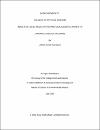| Abstract | The marine environment is facing major challenges due to several natural and anthropological stressors, including chemical and thermal pollutions released by coastal industries using seawater for cooling purposes. The Arabian Gulf is not an exception and during the last decades, the increased coastal industrial and urban development had just added more pressures on the already extreme environment. Chlorine is widely used in industrial processes for mainly i. Sterilization of sewage and pollutants and ii. Preventing the accumulation of organisms on hard substrates (bio-fouling) such as in power or desalination plants.
We carried out a laboratory experiment to identify the effects of exposure to chlorine on biological and physiological performance of the local pearl oyster Pinctada radiata. The experiment was run during 75 days at ExxonMobil Research Qatar with adult oysters (originally collected from AlWakra coastal waters) being exposed to two different concentration of chlorine (0.025 and 0.1 mg/l) and a control treatment.
Our results suggested that exposure to chlorine had non-significant effects on the mortality, growth and physiology (respiration rate) of healthy oysters. Analysis of the mortality registered throughout the experiments in all treatments (Kaplan Meier curves) suggested a higher final mortality rate (31.48%) for the oysters exposed to Cl concentration at 0.025 mg/l. This final rate was significantly different when compared with the other two treatments. In contract with this result, final mortality rates of oysters from the control treatment (11.76%) and exposed to 0.1 mg/l of chlorine (14.81%) were not significantly different.
Such non-effect of chlorine on mortality was also confirmed in oysters endpoints related to growth (i.e. length, width and height increments) and physiological (i.e. respiration rate).
Nevertheless, the experiment suggested that the size class of the considered oysters had a significant impact on mortality and growth, with larger specimens showing relatively lower performance than the smaller oysters.
These double evidences may be related to chemoreceptors located at the margins of the mantle of the oysters that may act as detectors of hazardous pollutants in the water and cause the closing of the valves. In addition, when transfer the oysters from its natural ecosystem to artificial one, outdoors affect in the laboratory as temperature, light; all lead to stress and decreasing in the physiological performance of oysters.
This will lead to both, decrease in feeding and prevention from toxicity, resulting in a reduced growth and lower susceptibility, respectively. |


